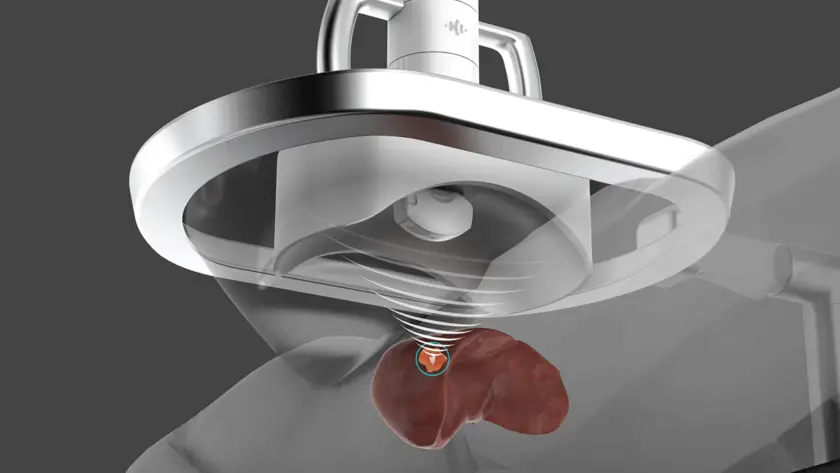Cancer treatment today often comes at a steep price. Chemotherapy’s potent cocktail of chemicals can wreak havoc throughout the body, leading to extreme nausea, nerve damage, and even organ failure. Radiation zaps away indiscriminately at both tumors and healthy tissue, potentially leading to new cancers down the road. Patients are often left wondering if the debilitating side effects are worth the risk.
But now, after decades of relying on these flawed weapons against cancer, a revolutionary new treatment is finally emerging. It uses precisely targeted sound waves to mechanically destroy cancerous tissues while leaving surrounding healthy tissue unharmed. This is unlike chemo drugs and radiation beams that are imprecise blunt instruments.
Remarkably, this groundbreaking therapy has recently gained FDA approval for prostate cancer. Known as histotripsy, it marks a major advance toward gentler, safer cancer care. By precisely targeting only cancerous cells and avoiding collateral damage, histotripsy heralds a new era of treatment. One where patients need not suffer through the grueling physical and emotional trauma of traditional therapies.
As researchers expand histotripsy into treating other common cancers, it promises to eventually displace chemotherapy and radiation entirely. The astronomical costs, both monetarily and physically, of these older therapies will soon be relegated to the annals of medical history. Histotripsy offers the hope that the war against cancer can be won while humanizing the process of healing.
The Evolution of Histotripsy
In the 1980s, researchers realized focused ultrasound could accidentally damage tissue by forming bubbles. At first this was seen as a problem to avoid. But it inspired new ideas for intentionally using bubbles to disrupt tissue. Groups tried techniques like shock wave therapy. However, early approaches lacked control over the bubbling process. Over many years, researchers incrementally improved parameters like waveform shape and pulse timing. This led to major advances in controlling and focusing the effects.
In the 2000s, the term “histotripsy” was coined at the University of Michigan. They pioneered using ultrasound imaging to guide the bubbles in real-time. This allowed tailored treatments. From there, histotripsy quickly progressed to human trials for applications like treating kidney stones. As the technology improved, more potential uses emerged. Histotripsy is now moving into cancer treatment and other areas. There is still much progress needed, but the fundamentals are established.
Histotripsy’s Mechanism
Histotripsy uses ultrasound pulses to make bubbles that break down tissue. The pulses are very short – just microseconds long. This is enough to make bubbles but prevents heating. There is a delay between pulses. This lets bubbles pop completely before the next pulse.
The bubbles are made in two main ways:
- The ultrasound by itself directly makes bubbles by exceeding a pressure threshold.
- An initial bubble bounces the ultrasound back to create more bubbles.
Either way, a cluster of bubbles is formed that explodes violently. The bubble explosions release targeted forces that break cell structures. After many pulses, the tissue liquefies into harmless cell fragments. The effects only occur in the precise focus spot, and surrounding tissues are unharmed.
The term “histotripsy” was coined at the University of Michigan in 2004 to describe a refined approach using shorter, higher pressure ultrasound pulses. Instead of the millisecond pulses used in shock wave therapy, histotripsy uses pulses just microseconds long. This achieves a higher density of controlled cavitation. The violent collapse of cavitation microbubbles produces tremendous stresses that fracture cell structures. Tissues liquefy into an acellular homogenate and are gradually resorbed.
Histotripsy’s Capabilities
Histotripsy’s unique mechanisms offer new possibilities for non-invasive tissue removal. The ability to liquefy tissue with extreme precision promises revolutionary applications not achievable with thermal ablation or radiation. With further development, histotripsy may one day displace older therapies for cancer and other diseases.
Its non-thermal nature avoids issues like the heat sink effect and unintended collateral damage. Histotripsy represents an exciting new chapter in therapeutic focused ultrasound.
Histotripsy has some really exciting capabilities that set it apart from other tissue ablation methods like heat or radiation. Here are a few key strengths:
Precision – Histotripsy liquefies just the targeted tissue, nothing else. This pinpoint accuracy results from the tightly focused ultrasound pulses and confined bubble effects. Surrounding healthy structures are left totally untouched.
Localization – There is no widespread toxicity or side effects throughout the body as with chemotherapy. Only the focused zone is affected, so effects don’t spread beyond the target.
Sparing – Important structures like blood vessels and ducts are not damaged by histotripsy. Collagen-rich tissues have a higher resistance threshold and remain intact. This tissue-selectivity is unique.
Non-Invasive – No incisions or punctures are required. Treatment can be completely extracorporeal. This makes many new treatment sites accessible.
These capabilities open up many exciting possibilities for histotripsy’s future applications, including:
- Treating tumors close to critical structures in organs like the brain or liver.
- Breaking up blood clots in vessels without collateral damage.
- Removing cancerous tissues prior to reconstructive transplant surgery.
- Targeting tumor sites that are difficult to access surgically.
- Providing a gentler, toxicity-free tumor debulking before chemotherapy.
The sky’s the limit as this technology continues advancing. Histotripsy could truly revolutionize treatment options across medical fields.
In Conclusion
The road ahead remains long, but histotripsy lights a path toward a new paradigm in cancer care. This innovative technology exemplifies the power of scientific ingenuity to push progress ever forward. Histotripsy offers hope that one day, a cancer diagnosis won’t come loaded with grueling trade-offs.
Patients may gently but decisively eliminate tumors with minimal side effects. They can walk out of treatment ready to embrace life’s joys, big and small. There is still much work to realize this vision. But histotripsy provides a compelling glimpse into a future where we conquer cancer with ever-increasing compassion. A future where science enables preserving life’s beauty on the journey back to health.





